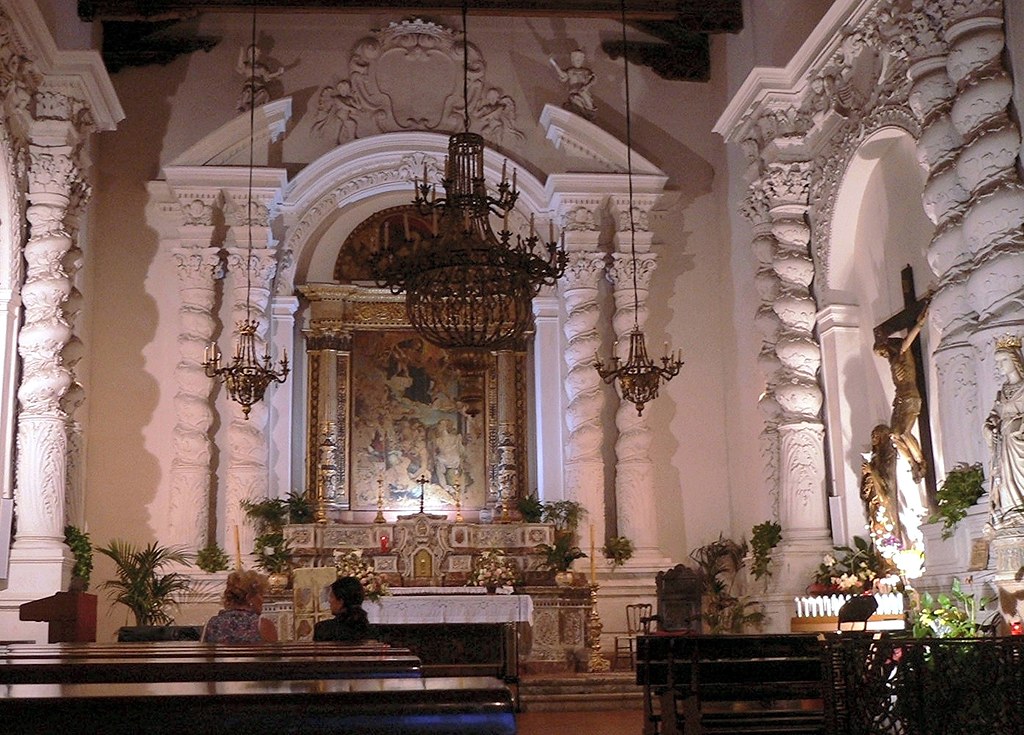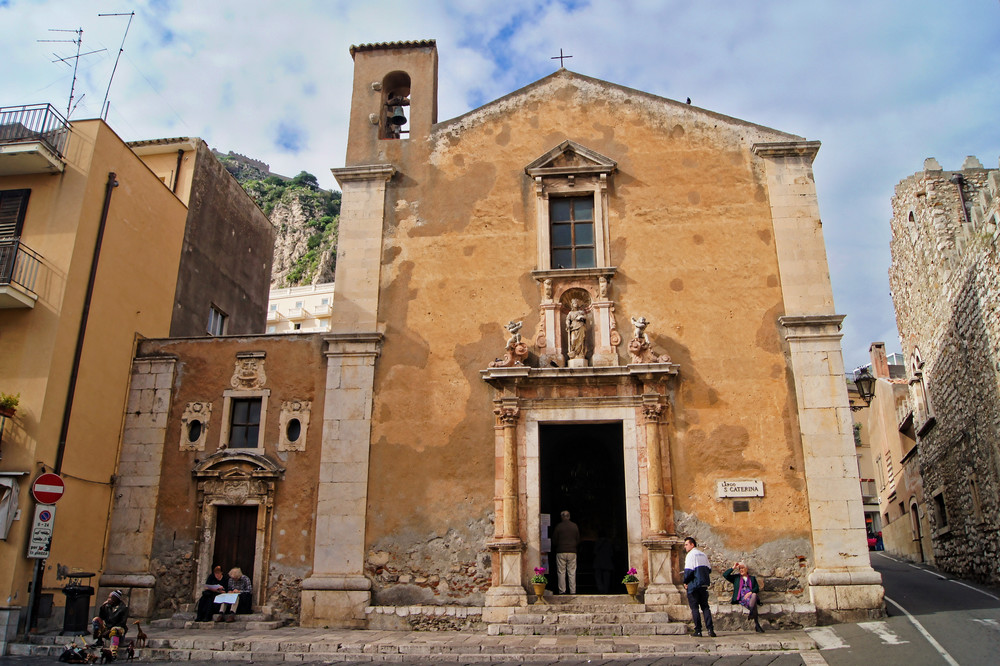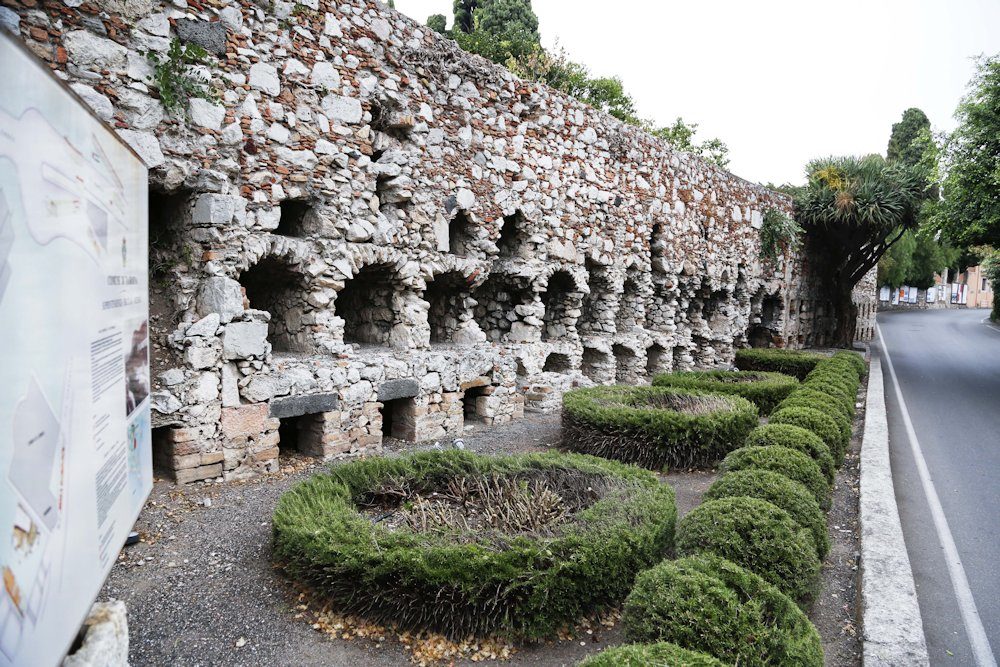Taormina To See
Taormina city centre is located on a hill at 206 m above sea level, suspended between rocks and sea, on a terrace of Mount Tauro, in a setting of natural beauty, unique for variety and contrasts, on the southern slopes of the Peloritani mountains ideal for off-road jeep excursions, Taormina old town overlooks on the Ionian coast with Etna volcano in the background.
GREEK THEATRE OF TAORMINA
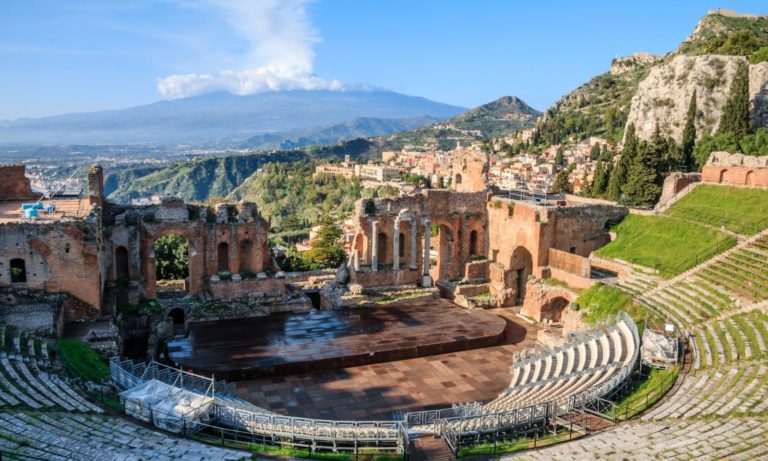
The first monument to see in Taormina, is without doubt the Ancient Greek Theater, that for vastness is the second of the classic theaters of Sicily (after the Greek Theater of Syracuse). The cavea is all carved into the rock and could hold up to 5,000 spectators. The first places were definitely reserved to the authorities. Even today, the cavea is divided into nine sections cuneiform, served eight ladders. A portico with large pillars surrounded the cavea towards the outside, and at one time the entrance was in the lower part where the embankment walls are still recognizable. Behind the scene, there were the “parascenia” the actors’ room and the scenic elements.
The construction of the theater starts by the Greeks around the III century BC, at the time of Hiero II. The theatre was built to accommodate dramatic performances or musical outdoor and to to discuss the political and economic community of the time. Only Greek men could access and assist, women were not allowed to enter.
During Roman era, the plant of the theatre was renovated and expanded with inserted of columns, statues and with strategic covers. Furthermore, the theatre of Taormina was transformed for gladiatorial battles. This involved the expansion of the orchestra, and was added the “conistra” to protect the spectators from many rappresentation between gladiators. The theater by the modifications of the Romans, became an amphitheater.
Very fortunate natural setting, with splendid view toward the Calabrian coast, the Ionian coast of Sicily and the spectacular cone of Etna volcano, still today maintains excellent acoustics.
In the east part of the cavea, there is a small Antiquarium, where few archaeological specimens remain because part of them are now in Naples, Messina and Siracusa, but one thing most interesting is a large square block of pink Taormina marble, formerly the base of a statue and properly on the front of this base an inscription reads “The Tauromenitani (the Taormina people) dedicate this statue to Olympio, winner of the horse race in the games at Olympia”, evidence that Taormina had a winner at the Olympic Games.
Many pillars intitolated for example, to “Strategists” who were not soldiers but those in charge of administering justice in Taormina, or the pillar of Gymnasiarchs, the magistrates in charge of the Gymnasium (Naumachie) where the young men were educated psychologically and physically.
There is also an interesting small oval sarcophagus in marble, probably made for a child this because its sculptures in high-relief involving children. Therefore in Taormina, as in Rome and Athens, documents related to the political, civil and financial system of the town were conserved “for eternity” as show the engraves on stones.
Porta Catania
Porta messina
Porta Catania is the end result of various changes and restorations, the last of which were performed in 1440 by the Aragonese and their coat-of-arms is sculpted in relief above the Taormina coat-of-arms in the centre, on the top part of the gate. Porta Catania and part of the city walls, enables access from the direction South to the main street of Corso Umberto I.
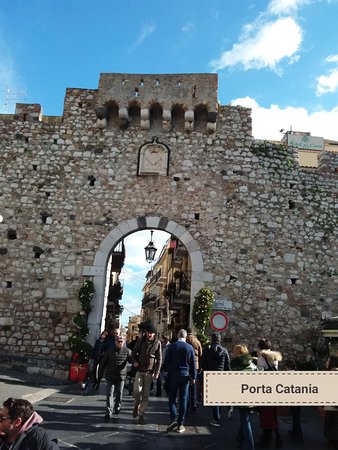
Porta Messina is located in the north entrance of the historical center of the town which leads to the main street of Corso Umberto I of the old town and the ancient fortified walls form part of circuit of walls with a triple fortification system.
Today you can see the plaque on top of the door placed in memory of his inauguration, commissioned by Ferdinand IV of Bourbon in 1808. In honor of the king, the port is also known as the “Gate Ferdinandea”.
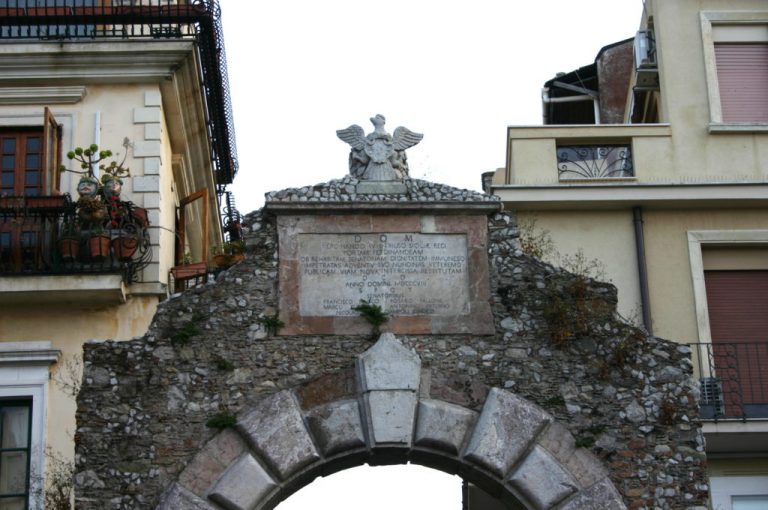
corso umberto i
palazzo corvaja
Corso Umberto I, is the main street of Taormina old town and leads from the Porta Messina north) across the city to the Porta Catania (south).
This pedestrian steet provides a lively promenade for tourists and is lined with elegant shops, bar and restaurants. Typical are the narrow streets full of colours and perfumes that intoxicate in the air, breathing a particularly relaxing air of a day off dedicated to leisure times. Piazza IX Aprile the main square, is situated at half between the two doors and close “Porta di Mezzo”, which forms the passageway that splits from the Greek-Roman part to the Medieval part.
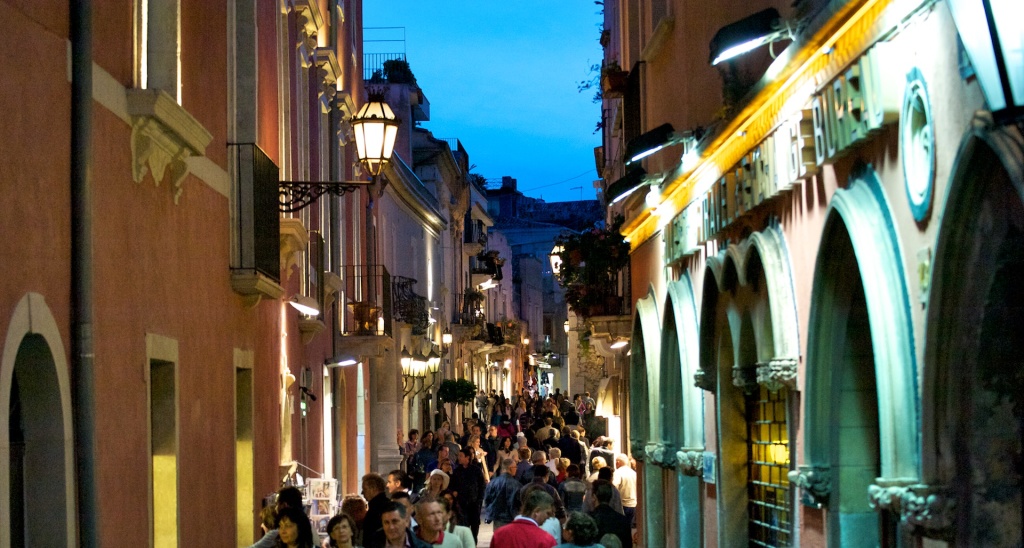
At the right corner to the church of Saint Catherine of Alexandria, there is Palazzo Corvaja. The first part of this palace is medieval and was built in the X century, when Arabs conquered the city from Byzantine Imperium. It was a cube tower that was used for defending the town. The tower was extended in the XIII and XIV century assuming the current characteristic mix of styles: Arabic (the tower), Gothic style (the shape of the windows) and Norman (composed by the XV hall of the Parliament) that during the period of 1411 the Sicilian Parliament that chose the King, in the presence of Queen Bianca of Navarra, regent of the Kingdom of Sicily). The mansion is named after the Corvaja family, one of the oldest and most noble families in Taormina. This powerful aristocratic family owned the palace from XVI – XX centuries giving it its final shape. On the South-West side there is the entrance portal with a staircase that goes from the courtyard to the first floor. On the landing there are three magnificent panels in Siracusa stone scuplted in high-relief: the first one pictures the creation of Eve; the second panel, the originai sin; and the third is of the expulsion of Adam and Eve from Paradise. Today, the Corvaja Palace host the Tourist Office and the Museum of Arts and Popular Traditions , which has a collection of Sicilian puppets and folk art and Sicilian carts.
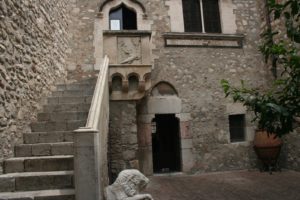
the clock tower
the fountain in piazza duomo
Traces of ancient walls can still be seen today not only in the centre of the town but also in the Clock-Tower where you can find it there is the castle tower and the Middle Gate next to Piazza IX Aprile. The Clock Tower splits the medieval village from the classical and Hellenistic part. The Clock Tower was built the first time in the XII century on the remains of an older defensive wall construction, dating back to the IV century BC, was razed to the ground by the invasion of the French troops of Louis XIV in 1679, at the behest of the villagers of Taormina, the Tower was rebuilt and on that occasion was also placed the large clock that today characterizes it. A particularity is that the bells of the bells of the Clock Tower are played at the party on the day of the election of the mayor, and on the occasion of the procession on the day of the patron saint San Pancrazio that occurs on July 9th.
Just in front of the Cathedral, stands the fountain of Piazza Duomo ypu can find the Fountain of Piazza Duomo, called also as “Four fountains”. The fountain was built in 1635 and it is in Baroque style, sormonted by three concentric steps in marble where on the base presents 4 columns located at the corners and which are surmounted by sea horses. The central part consists of 2 tanks: the one below is supported by four clumsy putti, the one above by monsters. On the outer edge of the large basin, the names of the administrators who ordered its construction are carved: Vincenzo Cacopardo – Cesare Cipolla – Vincenzo Spuches – Geronimo Mena. At the top, above the two pools, is the Minotaur, a half-human monster and a half-horse, which is the emblem of the city of Taormina. Depicted in the female version, it has two arms that hold a sphere and a scepter, symbols of power.
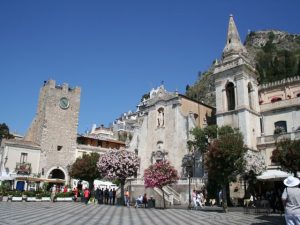
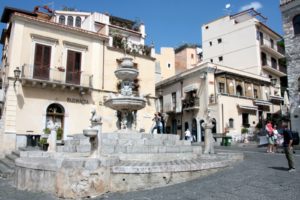
Roman ruins…
public garden of Lady Florence Trevelyan
Via Naumachie is a site to visit because it contains Roman ruins. It is a large construction formed by a brick wall, 122 meters long and 5 meters tall. It was built in Roman times and more precisely in the II century A.D. The name Naumachia literally means “naval battle” this beacuse once was believed that the monument was an aquatic circus, built by the Romans for the representation of naval battles.
In reality, the monument is a large nymphaeum with niches, that is, a monumental fountain with plays of water. This because during Romans years it was very important to built and to live near the presence of water that formed part a reserve for the whole town.
There was also a Gymnasium that was a construction with a rectangular perimeter, surrounded on its four sides by an arcade supported by columns. It was the place where young men were educated from both a civil-religious and operative point of view. In Taormina the only remaining wall of the antique Gymnasium rests on a double row of well-cut steps in Taormina stone which form the base of the wall.
Lady Florence Trevelyan, an English noblewoman lived in Taormina at the end of the XIX century and married the mayor of the city, Mister Cacciola. The noblewoman was had the park built as an english garden full of plants and flowers of different species and from all over the world. The fancy of the noblewoman is also evident in the buildings with the shape of a pagoda-style towers with arabesque designs, made of bricks and edged with lavic pumice-stone, still visible today, that Lady Florence, was an enthusiastic ornithologist, exploited as an observation point for birds.
The park has also a magnificent view that has as background Etna and the sea of Giardini Naxos.
Inside, there is a vegetation typically Mediterranean array of hedges and flower-beds with cobbled paths which lengthwise connect the almost three hectares of park. An avenue lined with olive-trees in memory of the fallen during various wars runs are precious trees of various species, some of which are rare and extraordinarily beautiful.
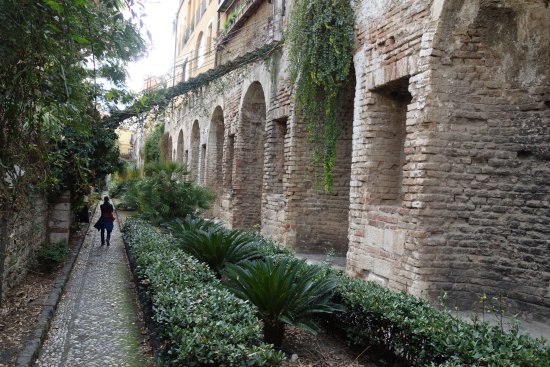
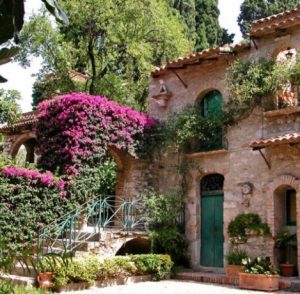
byzantine or arabian necropolis?
the roman odeon
Just arrived at "Porta Catania" at 2 km by car and on your left side,
you will find at Via Bagnoli Croci along the road that rom Capo Taormina,
leads up to the centre of the town,the Arabian necropolis even
though it is defined as Byzantine by many, it is rare evidence of the
daily aspects of long time ago. According to many studies about
the site, it is thought to was been created during
the X and XI century and is defined as a "columbary necropolis"
because the cells are symmetrical and situated one on top of each other.
The Roman Odeon, is located behind the St. Catherine’s Church and it was built when Taormina became a military colony in the year 21 B.C under Caesar Augustus Octavian, the first Roman emperor.
The Odeon was found accidentally in 1893 and it was used like a stage for musical and literary presentations, which were performed only for the elite of the city. The Odeon was a covered roman theatre with a capacity of less than 200 people.
The Odeon directed towards northeast was built with clay bricks and is divided into 3 parts: the scene, the orchestra and the cavea. Through a covered and central corridor (vomitoria), there was the possibility to arrive upper steps and lower steps, it depended on the social class of the spectators. Normally, in the upper steps, the plebs were sitting.
The Scene, consisted of the stylobate (base) and the peristyle (colonnade) of an Hellenistic temple of the Doric order, some people say, it was dedicated to Aphrodite. Close to the scene there was a dedicated room for actors.
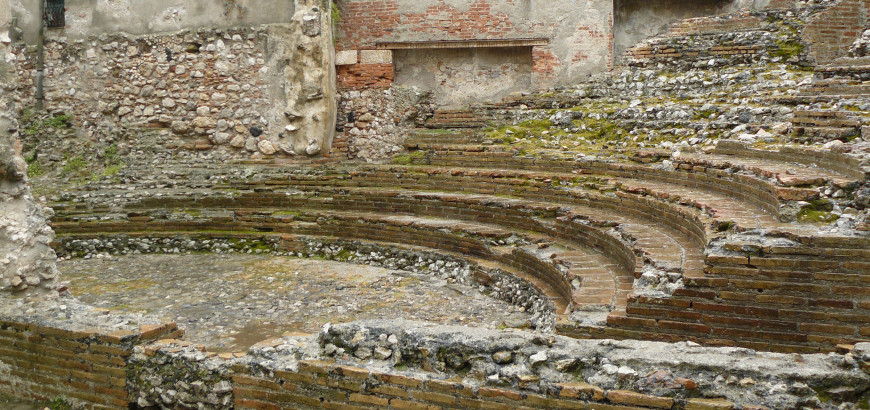
CHURCHES
the duomo St. Nicholas of Bari
Wonderful and a must see is the Cathedral of Taormina dedicated to the St. Nicholas of Bari, built on medieval ruins in 1400. The Dome is in Latin-cross plan with three aisles, one of this altar has the Byzantine Madonna that was found inside an old well and was probably placed there to save it from the many invasions and pillaging that went on during the Arabian era, although tradition tell that the Byzantine Madonna was left there by the angels. That is why it is called the “non hand-made” Madonna, meaning not made by human hands but by God. It is an oil painting on panel covered with a layer of silver and semi-precious stones and the painting was dedicated to Holy Mary of the Greeks.
Important in the Dome is the Polyptych by Antonello De Saliba.
The central nave is held up by six monolithic columns, three on each side, in pink Taormina marble and their capitals have a foil and fish-scale decoration. The ceiling of the nave has wooden beams supported by carved corbels reproducing Arabian scenes with a Gothic air. The very interesting main portal was rebuilt in 1636 and has a large Renaissance rosette.
Original are also the jambs with 12 figures on each side, the figures represent St. Paul (the keys), St. Peter (the sword of the faith), King David (the cithara) plus the four evangelists: St. Mark with a symbol of the Lion, San Giovanni with the Eagle, Luca with a Tauro and Matteo with the Angel, while in the two figures above there are two blessing bishops with miter and pastoral are Saint Nicholas who is the church and Saint Pancrazio patron of Taormina.
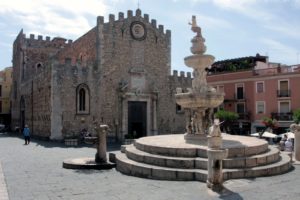
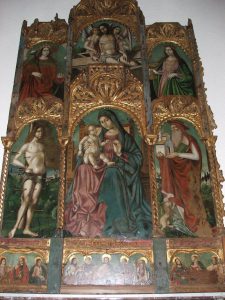
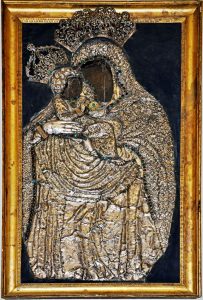
ST. PANCRA’S CHURCH
SHRINE TO OUR LADY OF THE FORTRESS
Via Largo di Giove Serapide and on the right side, there is the Church of the Patron of Taormina, St.Pancrazio. The church is a seventeenth-century building erected on the ruins of the Greek temple of Jupiter Serapis, it can be seen from the large stones built dry segments on the sides of the church and from Ionian column on each side. Inside the church, the intermediate floor with the organ can be seen above this portal. Two interesting oil paintings on canvas hang above the two minor altars on the right side of the church, one picturing the torture of St. Nicolò and the other the consecration of St. Maximus who was St. Pancras’ successor. Between the other two minor altars on the left of the church there is a fresco picturing Teofano Cerameo, Taormina’s last Bishop during the XI century. A railing in wrought iron separates the rest of the church from the main altar which is decorated with polichrome marble.
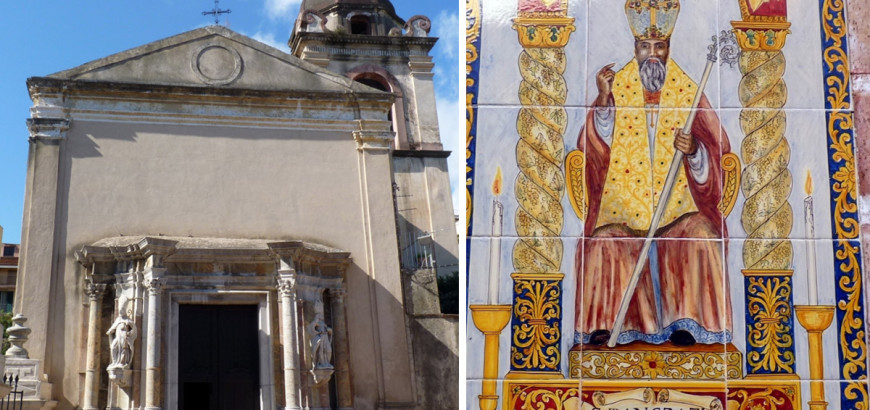
One of the tourists favourite sight-seeing attractions is founf up Monte Tauro in Taormina, we are talking about the Shrine to our Lady of the fortress that present also one of the most beautiful and suggestive panoramas in Taormina. The shrine was built in 1640, taking advantage of the rock structure which forms a grotto.
Not only, the Shrine is located also a few steps from the Saracen castle, situated in an elevated position above Taormina, at about 397m high. Probably it was an antique acropolis of the Greek town of Taormina. The Romans and later the Byzantines strengthened the site. In 902 AD the town fell to the Arabs after a siege of 2 years and where they rebuilt the castle form with a trapezoid plan adapted to the shape of the rock. The ruins of this fortification are constituted by an imposing tower with walled area with a cistern.
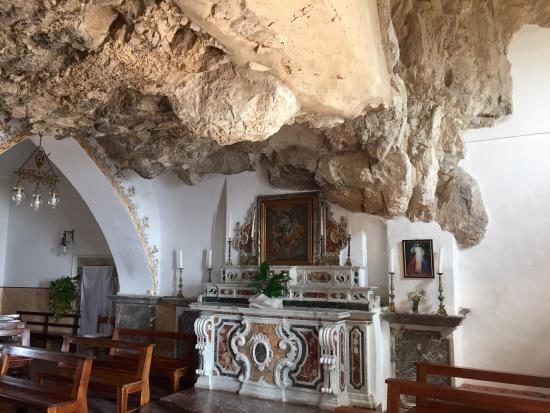
ST. Catherine’S CHURCH
The architectural style of the church is baroque, given the era in which it was built, ie 1600. A beautiful portal made with pink marble of Taormina, both in the jambs and in the lintel, opens in the facade, and is adorned on the sides by two columns with high bases and Corinthian style capitals supporting a broken pediment, also in Taormina pink marble. Above the portal, in a niche, there is the statue of the Saint Caterine of Alexandria in Egypt with at the sides two angels on the sides. The statue with a crown on the head, represent with the sword in the right hand and the palm on the left hand, the martyrdom, and it is attributed to the sculptor Paolo Greco who made it in 1705. The architrave reproduces the pediment of a Greek temple; this is another reason for inspiration deriving from the on-site existence of a Greek temple, which it is thought was dedicated to Aphrodite (Venus), from the symbol of the shell that adorn the facade of the Sacristy and the main monument of the entrance door.
The church of Saint Catherine,
was built on the top of the ruins of the Roman Odeon, destroying in part its orchestra and its scene which consisted of the southern colonnade of a Greek temple, some say dedicated to Aphrodite. The interior of the church is a single nave, with an elegant wooden trussed. On the main altar, you can see the painting depicting Saint Catherine’s martyrdom, attributed to the Sicilian painter Jacopo Vignerio (XVI century).
During a recent restoration in 1977, it was found below the main portal, an interesting crypt used to preserve and bury, previous mummification, the bodies of the notables and aristocrats of the town. At the end, on the right side of the church and under the floor, there are some ruins of walls of the Greek-Roman era, which have been left in sight for visitors.
